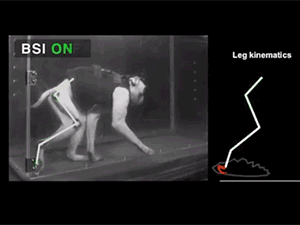
The rear left leg is normal, the rear right leg is being moved through wifi enabled electrodes. Source: http://spectrum.ieee.org
Researchers have successfully used wifi enabled electrodes to allow a monkey with nerve damage to walk again. From an article in the BBC:
Dr Gregoire Courtine, one of the researchers, said: “This is the first time that a neurotechnology has restored locomotion in primates.” He told the BBC News website: “The movement was close to normal for the basic walking pattern, but so far we have not been able to test the ability to steer.”
The technology connects the portion of the brain in control of motor function to the extremities of a Rhesus monkey with spinal cord damage. Signals that would normally flow along the spine, instead, travel over a wireless signal to electrodes that then signal nerves.
Implantable technology is nothing new but this development is monumental because the device is replacing a motor function that happens almost instantaneously. And, thanks to technology being created to transform Bluetooth signal (low power demand) into a wifi signal (high power demand), the possibility of implants in the brain and other parts of the body are capable of long and dependable operation.
I’m fascinated by this dislocation of electro-chemical signaling to electro-numerical signaling. Until now, chips implanted into the brain of a subject only collected data or controled simple robotic limbs. This device re-enables the use of the subject’s own body. Of course, the brain chip that allows a monkey to move its legs is not interpreting brain functions — it is only by-passing the damaged spinal cord. The cliche question to ask is whether someone can hack the wifi enabled transmitters.


